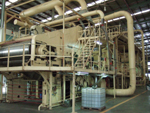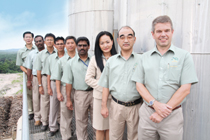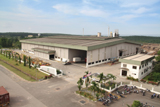A tight focus
10 February 2009With all the consolidation that has been going on in the SE Asian panel manufacturing industry it is in a way refreshing to find a company which is small, wishes to remain small, and knows exactly where it wants its market position to be.
Such a company is Segamat Panel Boards (SPB) in Segamat, Johor, in the south of peninsular Malaysia.
Owned by the Japanese Takeuchi
family, this company has been quietly producing its niche MDF products on a Mende-type calender line since it made its first board in 2003.
The Takeuchi family formerly owned another MDF factory with Mende-type line, in Masai, Johor and two continuous lines in Merbok as a joint venture called Merbok Hilir. The Merbok lines are now part of the Korean-owned Dongwha Group, while the smaller Masai factory is now part of the Evergreen Group
of Malaysia.
Recently, Segamat Panel Boards has expanded its operations in two directions.
Firstly, early in 2008, it bought an Indonesian-based particleboard mill,
formerly known as PT Novopan, in Pontianak, West Kalimantan.
Renamed PT Indopan Panel Boards (IPB), this mill has a Becker & Van Hüllen eight-daylight press line with a capacity of around 9,000m3 a month.
“Historically, Pontianak was very big in the wood business and a lot of particleboard plants like ours set up there in the 1990s,explained Peter Fitch, the English ex-pat who is managing director of the Segamat MDF operations. “There has since been a sharp decline in the availability of logs and so sawmills and plywood mills have closed. However, in the first quarter of 2008, political and policing changes reduced the illegal export of logs and the local Pontianak government decided to encourage downstream processing of the remaining wood resource, of plantation acacia, rubberwood and offcuts of mixed tropical hardwoods, from the remaining local sawmills.”
The Novopan mill had ceased production six months before SPB bought it from the receivers.
“We were able to restart the line quite easily and our immediate plans are to improve the quality, efficiency and productivity and to sell to the local domestic market, initially.
“In the longer term, we intend to produce low-emission board for export and, given the right market conditions, we have space on the site to build a new, probably continuous, line there,said
Mr Fitch.
“We went into this project 50/50 with a local joint-venture partner, which is one of the largest Indonesian furniture makers, and each company put in some experienced staff as well as re-employing some of the original local ex-employees.”
In addition to the panel production line, the factory came with a Hymmen low pressure melamine line and a short-cycle press line.
The second major recent move for SPB was the purchase of the entire production line of the former Greentech factory in Minden, Louisiana in the US from the receivers, who took control of Greentech in 2007.
This was a five-feet-wide calender-press line making thin particleboard and was first installed in 1996.
“Although this line had ceased production six months earlier, when I went over to Minden we produced particleboard from pallets straight away, which was also a good way of clearing out the site of waste wood at the same time as making panels and testing the line!said Mr Fitch, only half joking.
Delivery of the line was one third of the way through at the time of WBPI’s visit to Segamat in early December 2008, representing a stock of 42 containers of machinery so far.
“We are looking to produce thin particleboard in 2.5 to 6mm as an alternative to thin MDF, especially for more price-sensitive markets,said Mr Fitch.
In December, the ground was already being prepared and levelled on the Segamat site in preparation for the new factory buildings and Mr Fitch hoped to have the line up and running in April or May of this year.
He is no stranger to such pressure, having built up a Mende-type line for PTP in China under very difficult circumstances, and in a very short space of time, eight years ago (WBPI April/May 2002, p31).
The purchase includes a Bürkle laminating line for paper overlay.
“Initial capacity will be the same as Greentech had – 33,500m3 a year – but we hope to increase that figure by 20 to 30%, probably in a year’s time,said
Mr Fitch.
Another major project for SPB involved moving another company which it has owned for many years to the Segamat site.
Formerly located in Johor, UC Gravure Sdn Bhd is a printer of decor paper for application to panels by bonding with urea formaldehyde or PVA (poly vinyl acetate) resin.
A new factory building was erected at Segamat three years ago to accommodate UC Gravure’s two printing lines, which also come under Mr Fitch’s jurisdiction as director of the site.
With all this investment in a new factory in Indonesia, a new line for Segamat and the relocation of UC Gravure, SPB did not ignore the facilities it already had – far from it.
In 2007, the company put a new 3.3m diameter main heated drum in the calender press and modified the whole press.
“We also put in a new drum number two and fitted three densifying rollers in place of roller number three at the bottom of the press,explained Mr Fitch. Kelzenberg of Germany supplied the drums, while Binos, also of Germany, supplied the engineering and upgraded the human-machine interface (HMI).
In the same year, SPB purchased a spike roll former from Binos and the cumulative effect of all these upgrades was an increase in line speed of about 15%.
“It enabled us to achieve a higher density product, and a more consistent
product, of up to 900kg/m3 density,said the director.
The line is mainly producing 2.3 to 3mm MDF but can also manufacture up to 6mm board, although the lower price of this panel is not so attractive.
With declining availability of rubberwood, Segamat has also installed a new debarking and chipping line specifically for mixed tropical hardwood, employing a Fuji Kogyo debarker and disc chipper. The company does not mix its wood raw material, keeping to 100% rubberwood or 100% mixed tropical hardwoods in every board produced.
“We clean the logs thoroughly and have two-stage sifting to minimise the amount of latex getting through to
production,said Mr Fitch.
With a relatively small capacity of 75,000m3 a year, SPB maintains its philosophy of focusing on niche markets. “We modify our process to suit our customers’ specific requirements.
“We are doing a lot more low-emission [of formaldehyde] boards and we have CARB (California Air Resources Board) phase one and two certification already, inspected by PSI,said Mr Fitch.
Phase two (P2) is not actually due until 2011 so SPB is ahead of the game here. “We have also had JIS (Japanese Industrial Standard) certification since 2006 and are able to offer F*** and F****, mainly for Japanese customers,he said.
The panels are offered in 100% rubberwood or mixed tropical hardwood. “It is all about giving the customer a choice,said Mr Fitch. “You have to be focused on what the customer wants in order to survive.”
Perhaps partly because it is a Japanese-owned company and the Japanese know a lot about business efficiency systems, SPB has implemented an ERP (Enterprise Resource Planning) system on the management side, covering all aspects of the business from purchasing to sales and everything in between, with the data all processed on a central computer system.
“This ties in nicely with our ongoing internal programmes of LEAN manufacturing,said Mr Fitch, referring to the business/software system for maximising optimisation of resources in a company.
“The only way to maintain our
competitiveness is to be super-efficient because we are not a big producer,”
concluded Mr Fitch.
“Our ambition is to remain a small, niche player, committed both to quality and to our customers.”


